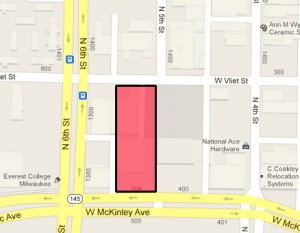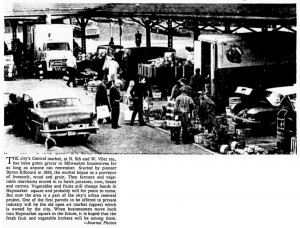Last year I posted an article from 1880 talking about the many public squares that the city had in use. One which was lost due to urban renewal in the late 1960s was Haymarket Square at 5th & McKinley. The area is now mostly taken up by a large WE Energies substation and several vacant buildings. The dismantling of the Park East freeway on the other side of McKinley has left a large area waiting for development and improvement.
Questions have come up, especially at the recent Envisioning the Seen program sponsored by Historic Milwaukee, Inc., as what should be done to spur development of the Park East. I say we should bring back a public market square. This would be instantly used by residents at Hillside Terrace who have no grocery or market nearby and would help to promote mixed use development in the Park East. Markets elsewhere in the city are well used as a source for fresh, healthy and cheap vegetables.
Public parks and markets are places in the city which can turn vacant space into used space and provide something which can attract development. How many developers want to take a risk on a vacant area that has no life? An actively used public space will make adjacent lands that much more valuable and attractive.
Unfortunately after Richard Perrin made the decision in 1966 to squeeze the last of the activity out of the area with the urban renewal project, the seeds of development could never take root and today we are left with vacant buildings and deserted space.
Milwaukee Journal, October 26, 1966
Haymarket Square Draws No OppositionThe proposed Haymarket Sqaure urban renewal project was discussed at a one hour public hearing Tuesday. No objections were heard from the more than 70 persons present. Eleven persons said they favored the project.
The 60 acre, L-shaped area is bounded roughly by W. Walnut, N. 3rd, W. McKinley, N. 8th, W. Vliet and N. 6th. Nearly 21 acres will be cleared and 14.4 acres rehabilitated. Streets and alleys occupy the other acreage.
The city redevelopment authority hopes to remove all residential structures from the area making the land available for expansion of existing businesses and for new industry.
The authority is not expected to give its final approval to the plan until Nov. 10 because it must allow property owners 15 days from the hearing, or until Nov. 9, to file written objections. Final action then will be sought from the common council.
1968 Target Date
Richard W. E. Perrin, the authority’s secretary, said land acquisitions could begin by next January. By mid-1968, he said, it is possible that all land involved will have been acquired and cleared.
The entire $3,241,058 cost of the project will be borne by the city – making it the first such project in which no federal funds for renewal will be used. The city is expected to recoup about $1,600,000 from the resale of land to developers, placing the project’s net cost at $1,640,000.
According to a new survey, the city will have to relocate 60 families, 166 individuals, 55 businesses, and 7 institutions from the area. City planners had estimated earlier that the project would uproot 133 families and 75 individuals.
Beautification Urged
At the hearing Richard Bosely, owner of Graphic Studios, 1331 N. 3rd st., asked that the project be amended so that something could be done to beautify the east side of N. 3rd. Much of it consists of railroad lines and loading-unloading areas.
Calling the street the “front yard” of the project because it carries heavy traffic to and from the downtown area, Bosely suggested that a brick retaining wall with greenery on top be used to screen that side of the street.
John Budzien, representing Milwaukee Gowers, Inc., 519 W. McKinley av., urged the retention of the farmers’ market in the area. Its proposed removal, he said, would create an economic hardship for the firm.

